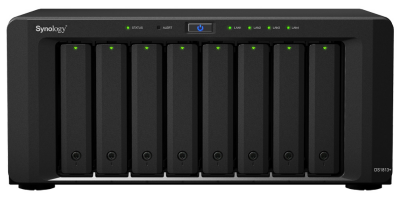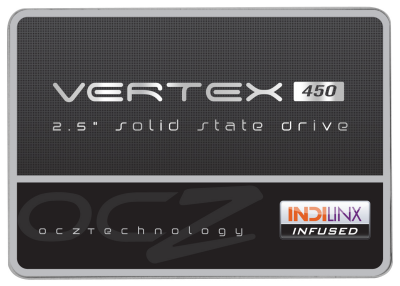- Details
- Network Storage
Hot on the heals of the new five-bay DS1513+, Synology America Corp. is pleased to introduce the DS1813+, the latest high-capacity, eight-bay, network attached storage (NAS). Designed for increased performance, reliability, and ease of use, the DS1813+ is an excellent addition to a creative workflow; by building on a centralized resource for accessing, editing, and sharing data.

The DS1813+ provides eight screw-less drive bays, which support both 3.5" and 2.5" mechanical or SSDs. That equates to roughly 32TB of raw storage capacity in the head-unit alone for creative pros to start with. By adding two DX513 expansion units, the DS1813+ can be grown out to 18 total bays, offering up to 72TB of raw data and your choice of either Synology Hybrid RAID (SHR) or classic RAID.
The DS1813+ comes with four Gigabit NICs, which bring powerful enterprise storage options like Synology High Availability, which helps to minimize downtime in the event of node failure by failing over to a mirrored DS1813+.
- Details
- Flash Memory
Plextor, a leading developer of high-performance digital storage technology, will preview the next generation of SSD (solid-state drive). In addition to multi-award winning consumer SSDs and specialized solutions for industry and enterprise, the Plextor booth will house the first 1Y-nm flash based SSD.
The industry and enterprise products on display include the tiny eMMC, mSATA SSDs, and NGFF SSDs, and a 2.5-inch ultra-high endurance SLC SSDs. An extreme temperature resistant power protected MLC SSD will also be shown as a sample of the advanced, customized solutions available from Plextor. This drive is capable of delivering random maximum read/write speeds of 94,000/81,000 IOPS at temperatures between -40 and +85°C. The SSD utilizes tantalum capacitors to prevent data loss in the case of power interruption.
Consumer products on display include the multi-award winning 100K IOPS capable M5 Pro Xtreme, entry-level M5S, and the new M5M mSATA SSD. Further details of the 1Y-nm flash based SSD also on display will be released later.
- Details
- Optical Storage
 One-Blue, LLC, the one-stop shop for patent licenses from the leading providers of Blu-ray Disc technology, today announced that One-Blue and certain One-Blue patent owners have filed suit against Imation Corp. for infringing patents essential to manufacture Blu-ray Disc products.
One-Blue, LLC, the one-stop shop for patent licenses from the leading providers of Blu-ray Disc technology, today announced that One-Blue and certain One-Blue patent owners have filed suit against Imation Corp. for infringing patents essential to manufacture Blu-ray Disc products.
The complaint, filed in the United States District Court for the District of Delaware, asserts that Imation Corp., a seller of Blu-ray Disc products under the Imation, TDK and Memorex brands, has infringed six (6) U.S. patents: 7,290,272; 7,389,520; 7,292,509; 7,123,567; 7,349,309; and 7,158,472. These patents are included in the portfolio offered for license by the One-Blue licensing program.
“The One-Blue patent pool provides companies with a fair and cost effective mechanism for obtaining Blu-ray Disc product licenses,” said Mr. William J. Lenihan , Director IP Licensing, One-Blue. “We filed this patent infringement suit in order to maintain a level playing field for the members of the One-Blue patent pool—licensors and licensees alike who manufacture and sell Blu-ray Disc products. We have a duty to ensure that all companies selling Blu-ray Disc products honor the essential patents in the One-Blue pool.”
Add a comment- Details
- Flash Memory
![]() Silicon Power, the world’s leading provider of memory storage solutions presents you with a newly designed USB flash drive – Jewel J10. Combined with high technology and sleek design, the Jewel J10 enables you to show your extraordinary taste anytime and anywhere. This Northern Europe inspired design is not just another ordinary memory storage device but also a luxurious accessory which allows you to express yourself.
Silicon Power, the world’s leading provider of memory storage solutions presents you with a newly designed USB flash drive – Jewel J10. Combined with high technology and sleek design, the Jewel J10 enables you to show your extraordinary taste anytime and anywhere. This Northern Europe inspired design is not just another ordinary memory storage device but also a luxurious accessory which allows you to express yourself.
SP Jewel J10 will catch your eye with its stainless steel design and remarkable appearance, making itself a perfect combination of style and practicability. With the weight of 3.1g, J10 will amaze you with its mobility and convenience. Accompanied with advanced application of USB3.0 COB (Chip on Board), Jewel J10 is able to not only protect the golden finger from scratches but also prevent itself from damages caused by water, dust and vibration. Furthermore, the creative groove design ensures that your USB is only a keychain away.
- Details
- Hard Disks
 WD, a Western Digital company and world leader for storage deployed in datacenters, today announced availability of its innovative WD Se line of hard drives, the first designed for scale-out datacenter deployments. Built on an enterprise-grade platform for reliable 24x7x365 datacenter operation, WD Se is tailored to deliver the right combination of performance, reliability and robustness for large-scale replicated environments, mid-sized network attached storage (NAS) deployment, and backup/archiving applications.
WD, a Western Digital company and world leader for storage deployed in datacenters, today announced availability of its innovative WD Se line of hard drives, the first designed for scale-out datacenter deployments. Built on an enterprise-grade platform for reliable 24x7x365 datacenter operation, WD Se is tailored to deliver the right combination of performance, reliability and robustness for large-scale replicated environments, mid-sized network attached storage (NAS) deployment, and backup/archiving applications.
WD Se is a true enterprise-class drive with the right blend of affordability and capabilities to address the massive growth of semi-structured data, which is accelerating the scale-out of datacenters of all sizes. Now shipping in capacities up to 4 TB, the new WD Se hard drives enables customers to balance their data growth challenges in multi-drive enclosures without compromising enterprise-class features.
- Details
- Flash Memory
Verbatim, a global pioneer of electronic data storage technology including optical media and flash memory, has expanded its popular and highly rated V3 Store’n’Go USB drive range with a product line offering faster connection and data transfer speeds. The V3 MAX delivers the fastest speed of any Verbatim USB drive.

With USB 3.0 connectivity that is backwards compatible with USB 2.0 ports, the V3 Max has a very impressive read speed of up to 175MB/sec and a write speed of up to 80MB/sec. It is available in storage capacities of 16GB, 32GB, 64GB and 128GB.
The V3 Max’s sleek appearance is boosted by a UV protective coating on its highly polished case to add further protection against scratches and marks from everyday wear and tear.
- Details
- Flash Memory
OCZ Technology Group, Inc., a leading provider of high-performance solid-state drives (SSDs) for computing devices and systems, today announced the release of the Vertex 450 SATA III SSD Series featuring the company’s proprietary Indilinx Barefoot 3 M10 Series controller. As part of the leading-edge Vertex series, Vertex 450 lives up to its name and bridges the gap between high performance and mainstream solid-state storage. With advanced storage performance, reliability, and quality, the Vertex 450 utilizes 20nm process geometry NAND flash to meet the needs of today’s high-end consumer and client applications.

“As one of the industry’s most highly awarded SSD Series to date, the Vertex name has become synonymous with the latest and greatest in flash-based storage providing an exceptional balance of performance and cost efficiency,” said Daryl Lang, Senior Vice President of Product Management for OCZ Technology. “The Vertex 450 marks the first time this popular OCZ series utilizes in-house ASIC technology delivering an even greater level of speed, reliability and value for our customers.”
- Details
- Flash Memory
 Innodisk, a designer and manufacturer of SSDs for commercial and industrial applications, announces a release of the industrial-embedded industry's first SATA device in accordance to SATA µSSD standards – nanoSSD.
Innodisk, a designer and manufacturer of SSDs for commercial and industrial applications, announces a release of the industrial-embedded industry's first SATA device in accordance to SATA µSSD standards – nanoSSD.
Through the integration of a control chip, flash memory and peripheral power components into a single ball grid array (BGA) package, Innodisk has managed to reduce the size of the nanoSSD to approximately 1% the size of a 2.5” SSD. With dimensions of only 16 x 20 x 2 mm (WxLxH), a weight of only 1.5g, SATA III support, capacities ranging from 4 to 64 GB and both x86 and ARM compatibility, nanoSSD can be incorporated into a wide variety of applications where a small form-factor and high transfer rates are important, including industrial mobile devices, embedded systems, tablets, high-end smart phones and Ultrabooks.
Innodisk's nanoSSD not only offers the advantage of an incredibly small form factor, as a result of the integration of DRAM into a BGA, this product also features high read/write speeds of 480/175 MB/s, respectively. Whether for purposes of system booting, data storage, or data cache backup, nanoSSD can significantly improve overall system performance.
- Details
- Flash Memory
SanDisk Corporation, a global leader in flash memory storage solutions, today announced it has begun customer sampling of flash memory products based on its industry-leading 1Ynm process technology, which represents its second generation 19 nanometer (nm) manufacturing technology.
SanDisk’s achievement of this breakthrough in semiconductor manufacturing takes its memory cell size from 19nm-by-26nm to 19nm-by-19.5nm, delivering a 25 percent reduction of the memory cell area and allowing SanDisk to continue leading the industry in building smaller, more powerful flash memory products.
SanDisk’s second-generation 19nm memory die uses the most sophisticated flash memory technology node to-date, including advanced process innovations and cell-design solutions. SanDisk's All-Bit-Line (ABL) architecture with proprietary programming algorithms and multi-level data storage management schemes help yield multi-level cell (MLC) NAND flash memory chips that do not sacrifice performance or reliability. In addition, SanDisk’s three bits per cell X3 technology, implemented in the second-generation 19nm node will deliver the lowest-cost flash solutions to address multiple growing end-markets for flash memory.
- Details
- Flash Memory
Toshiba Corporation and Toshiba America Electronic Components, Inc., (TAEC), a committed leader that collaborates with technology companies to create breakthrough designs, today announced that the company has developed second generation 19 nanometer process technology that it will apply to mass production of 2-bit-per-cell 64 gigabit NAND memory chips later this month.

Toshiba has used the new generation technology to develop the world's smallest 2-bit –per-cell 64 gigabit NAND memory chips, with an area of only 94 square millimeters. Using a unique high speed writing method, the next generation chips can achieve a write speed of up to 25 megabytes a second - the world's fastest class in 2-bit-per-cell chips.
Toshiba is also developing 3-bit-per-cell chips by using this process technology and aims to start mass production in the second quarter of this fiscal year. The company will initially introduce 3-bit, multi-level-cell products for smartphones and tablets by developing a controller compatible with eMMC, and will subsequently extend application to notebook PCs by developing a controller compliant with solid state drives (SSD).

